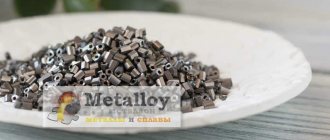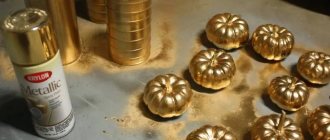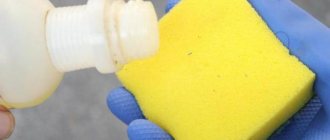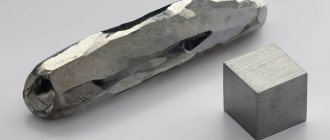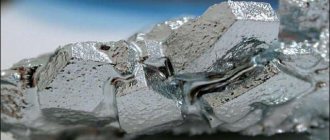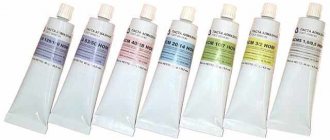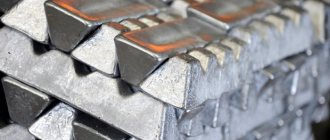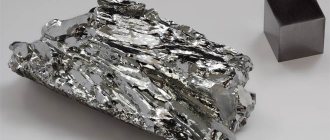Chromium – is an element of the secondary subgroup of the 6th group of the 4th period of the periodic table, 24 – atomic number, designation – Cr.
- The appearance of the substance is a solid metal of bluish-white color.
- Melting point – 2130 K.
- Boiling point – 2945 K.
- The lattice structure is body-centered cubic.
Chrome is a slightly bluish silvery-white metal. The name comes from the Greek word chroma and means color (due to the varied colors of chromium compounds). Due to its high corrosion resistance, it is a popular material for protecting materials from environmental influences.
Chromium with iron, manganese, nickel , titanium , and vanadium form one geochemical family. Chromium is an important alloy component for stainless heat-resistant steels. Chromium (VI) compounds are extremely toxic.
Chromium is weather resistant because, like aluminum , it is coated with an oxide layer that protects it from further reactions. Reacts with acids to form the corresponding salts and hydrogen . When heated, it reacts with non-metals such as chlorine , sulfur , carbon and silicon .
Chromium ions (often combined with oxygen) have typical colors:
- chromate ion: yellow;
- dichromate ion: orange;
- polychromate ion: dark red;
- peroxochromate ion: blue.
Physical properties
Chromium is one of the refractory metals. The melting point is 1900 C higher than that of platinum (1772 C). The density is close to that of iron and niobium. The modulus of elasticity of chromium is the lowest compared to molybdenum and tungsten.
Thermophysical properties
For refractory metals, the linear coefficient of thermal expansion is usually low and thermal conductivity is high. However, chromium does not exhibit the typical behavior of molybdenum or tungsten.
Its coefficient of thermal expansion is relatively high. At temperatures of 38 C and above, a transition from antiferromagnetism to paramagnetism occurs and the coefficient of thermal expansion increases very sharply. This transition temperature (Nel temperature) is a first-order phase transition and shows a significant volume jump that greatly affects the linear coefficient of thermal expansion.
Story
Chromium atom diagram
In 1766, a mineral was discovered in the vicinity of Yekaterinburg, which was called “Siberian red lead”, PbCrO4. The modern name is crocoite. In 1797, the French chemist L.N. Vauquelin isolated a new refractory metal from it (most likely Vauquelin obtained chromium carbide).
origin of name
The element received its name from the Greek. χρῶμα - color, paint - due to the variety of colors of its compounds.
Production
The main deposits of chrome ores in the Russian Federation are known in the Urals (Don and Saranovskoye).
Explored reserves in Kazakhstan amount to over 350 million tons (or 1st place in the world)
Mechanical properties
Chromium, as a body-centered cubic metal such as molybdenum and tungsten, exhibits a brittle-to-ductile transition temperature of -50 C to 350 C. The greatest influence on the brittle-ductile transition temperature is the purity of the element, particularly the nitrogen and oxygen content. However, other alloying elements, microstructure and degree of deformation also have a significant effect on the transition temperature.
Fully recrystallized chromium exhibits absolutely no ductility at room temperature, but if the chromium is deformed or annealed, the material becomes ductile.
The strength of chromium increases with increasing strain and can be further increased by using various alloying elements.
Chromium has a relatively low melting point of 1900 C compared to other refractory metals - molybdenum and tungsten. The elastic modulus is also relatively low. Compared to tantalum and niobium - both of which have a higher melting point - chromium has a much higher elastic modulus.
Main characteristics
The characteristics of the chemical element chromium are due to the fact that it is a transition metal of the fourth period of the periodic table and is located between vanadium and manganese. Included in group VI. Melts at a temperature of 1907 °C. In the presence of oxygen, chromium quickly forms a thin layer of oxide, which protects the metal from further interaction with oxygen.
As a transition element, it reacts with substances in different proportions. Thus, it forms compounds in which it has different oxidation states. Chromium is a chemical element with basic states +2, +3 and +6, of which +3 is the most stable. In addition, in rare cases conditions +1, +4 and +5 are observed. Chromium compounds in the +6 oxidation state are strong oxidizing agents.
What color is chrome? The chemical element gives anodized aluminum its ruby hue. Cr2O3, used for polishing metal, is also used as a pigment called chrome green. Its salts color glass emerald green. Chromium is the chemical element whose presence makes rubies red. Therefore, it is used in the production of synthetic rubies.
Chemical properties
Chromium is known to most people as an alloying element in stainless steel and as a protective layer in various products. Chromium forms a thin transparent passive layer (Cr2O3) upon contact with any aggressive media such as oxygen. This protective layer is absolutely stable in normal atmosphere and in aquatic environments. Therefore, the use of chromium as a decorative and anti-corrosion layer is very common.
Cr2O3 also reliably protects chromium from aggressive acids such as sulfuric or nitric acids. In internal combustion engines such as gas turbines or diesel engines, chromium is resistant to hot gases at temperatures up to 1000 C.
Ferrochrome. Chrome plating.
For many decades since the discovery of the metal chromium, only crocoite and some of its other compounds were used as pigments in the manufacture of paints. In 1820, Kochlen proposed using potassium dichromate as a mordant for dyeing fabrics. In 1884, the active use of soluble chromium compounds as tannins in the leather industry began. Chromite was first used in France in 1879 as a refractory substance, but its main use began in the 1880s in England and Sweden, when the industrial smelting of ferrochrome began to increase in speed. They were able to obtain ferrochrome in small quantities already at the beginning of the 19th century, so Berthier, back in 1821, proposed reducing a mixture of iron and chromium oxides with charcoal in a crucible. The first patent for the manufacture of chromium steel was issued in 1865. Industrial production of high-carbon ferrochrome began using blast furnaces to reduce chromite with coke. Ferrochrome late 19th century. was of very low quality, as it usually contained 7–8% chromium, and was known as “Tasmanian pig iron” due to the fact that the original iron-chromium ore was imported from Tasmania. The turning point in ferrochrome production came in 1893, when Henri Moissan first smelted high-carbon ferrochrome containing 60% Cr. The main achievement in this industry was the replacement of the blast furnace with an electric arc one, created by Moissan, which made it possible to increase the temperature of the process, reduce energy consumption and significantly improve the quality of the smelted ferrochrome, which began to contain 67–71% Cr and 4–6% C. Moissan’s method is still por lies at the basis of modern industrial production of ferrochrome. Chromite reduction is usually carried out in open electric arc furnaces, and the charge is loaded from above. An arc is formed between electrodes immersed in the charge.
Despite the great importance of high-carbon ferrochrome for the production of many types of stainless steels, it is not suitable for smelting some high-chromium steels, since the presence of carbon (in the form of Cr23C6 carbide, crystallizing along the grain boundaries) makes them brittle and easily susceptible to corrosion. The production of low-carbon ferrochrome began to develop with the beginning of the use of industrial aluminothermic reduction of chromite. Nowadays, the aluminothermic process has been replaced by the silicothermic process (Perrin process) and the simplex process, which consists of mixing high-carbon ferrochrome with partially oxidized ferrochrome powder, subsequent briquetting and heating to 1360 ° C in a vacuum. Ferrochrome prepared by the simplex process typically contains only 0.008% carbon, and briquettes made from it are easily dissolved in molten steel.
The ferrochrome market is cyclical. World production of ferrochrome in 2000 was 4.8 million tons, and in 2001, due to low demand, 3.4 million tons. In 2002, the demand for ferrochrome intensified again. The first place in the world in ferrochrome smelting is occupied by the South African “Big Two” – Xstrata South Africa (Pty) Ltd. (a subsidiary of Xstrata AG) and Samancor Chrome Division (a subsidiary of Samancor Ltd.). They account for up to 40% of the world's ferrochrome smelting. In South Africa and Finland, mainly charge chrome is produced (from the English charge - load coal), containing 52–55% Cr, and in China, Russia, Zimbabwe, Kazakhstan, ferrochrome containing more than 60% Cr. Ferrochrome is used as an alloying additive for low alloy steels. With a chromium content of more than 12%, steel almost does not rust.
The corrosion resistance of iron alloys can be significantly increased by applying a thin layer of chromium to their surface. This procedure is called chrome plating. Chrome-plated layers are well resistant to exposure to humid atmosphere, sea air, tap water, nitric and many organic acids. All chromium plating methods can be divided into two types - diffusion and electrolytic. The Becker-Davis-Steinberg diffusion method involves heating a chrome-plated product to 1050–1100° C in a hydrogen atmosphere, filled with a mixture of ferrochrome and refractory, pre-treated with hydrogen chloride at 1050° C. The CrCl2 located in the pores of the refractory evaporates and chromes the product. During the electrolytic chromium plating process, metal is deposited on the surface of the workpiece, which acts as a cathode. The electrolyte is often a hexavalent chromium compound (usually CrO3) dissolved in aqueous H2SO4. Chrome coatings are either protective or decorative. The thickness of protective coatings reaches 0.1 mm; they are applied directly to the product and give it increased wear resistance. Decorative coatings have an aesthetic value and are applied to a sublayer of another metal (nickel or copper), which performs the actual protective function. The thickness of such a coating is only 0.0002–0.0005 mm.
Receipt
The element chromium is relatively common on earth. The most important ore is chromium iron (chromite) – FeCr2O4. Large quantities of chromite are mined in South Africa, Russia, India, Brazil, Finland and Turkey. Elemental chromium may be found in iron meteorites.
The most important mineral for industrial chromium production is chromite (FeCr2O4). More than half of the chromite mined in the world comes from South Africa. The two most important products of chromite processing are ferrochrome and chromium metal. The largest consumer of ferrochrome is the steel industry, which uses chromium to produce stainless steels.
The metal is extracted industrially from chromite ore. The mineral is mixed with soda and lime . It is then oxidized in an air-fed rotary kiln. This results in the formation of sodium chromate (Na2CrO4), which is converted to sodium dichromate (Na2Cr2O7) with concentrated sulfuric acid. After crystallization, it reacts with carbon (coke) and sulfur. The resulting oxide is reduced to chromium with the help of aluminum.
From it you can obtain ferrochrome, which is used for the manufacture of alloy steels. To obtain pure chromium, the following reactions are carried out:
- Sodium carbonate is fused with iron chromite in air.
- The resulting sodium chromate is separated from the iron oxide;
- Pure chromium oxide is then obtained from crystallized sodium dichromate by reducing it with carbon.
Chromium metal is produced using aluminothermy. But the process of silicothermy (Peren process) is now becoming increasingly important.
Characteristics of a simple substance and industrial production of metallic chromium.
Chrome is a silvery metal with a density of 7200 kg/m3. Determining the melting point of pure chromium is an extremely difficult task, since the slightest impurities of oxygen or nitrogen significantly affect the value of this temperature. According to the results of modern measurements, it is equal to 1907° C. The boiling point of chromium is 2671° C. Absolutely pure (without gas impurities and carbon) chromium is quite viscous, malleable and malleable. At the slightest contamination with carbon, hydrogen, nitrogen, etc. becomes brittle, brittle and hard. At ordinary temperatures it exists in the form of an a-modification and has a body-centered cubic lattice. Chemically, chromium is quite inert due to the formation of a strong thin oxide film on its surface. It does not oxidize in air even in the presence of moisture, and when heated, oxidation occurs only on the surface. Chromium is passivated by dilute and concentrated nitric acid, aqua regia, and even when the metal is boiled with these reagents, it dissolves only slightly. Chromium passivated by nitric acid, unlike metal without a protective layer, does not dissolve in dilute sulfuric and hydrochloric acids, even after prolonged boiling in solutions of these acids; however, at a certain moment, rapid dissolution begins, accompanied by foaming from the liberated hydrogen - from the passive form chromium becomes activated, not protected by an oxide film:
Cr + 2HCl = CrCl2 + H2
If nitric acid is added during the dissolution process, the reaction immediately stops - the chromium is again passivated.
When heated, chromium metal combines with halogens, sulfur, silicon, boron, carbon and some other elements:
Cr + 2F2 = CrF4 (with an admixture of CrF5)
2Cr + 3Cl2 = 2CrCl3
2Cr + 3S = Cr2S3
Cr + C = mixture of Cr23C6 + Cr7C3.
When chromium is heated with molten soda in air, nitrates or chlorates of alkali metals, the corresponding chromates (VI) are obtained:
2Cr + 2Na2CO3 + 3O2 = 2Na2CrO4 + 2CO2.
Depending on the required degree of metal purity, there are several industrial methods for producing chromium.
Possibility of aluminothermic
reduction of chromium(III) oxide was demonstrated by Friedrich Wöhler in 1859; however, this method became available on an industrial scale as soon as it became possible to obtain cheap aluminum. The industrial aluminothermic production of chromium began with the work of Goldschmidt, who was the first to develop a reliable method for regulating the highly exothermic (and therefore explosive) reduction process:
Cr2O3 + 2Al = 2Cr + 2Al2O3.
Previously, the mixture is uniformly heated to 500-600 ° C. Reduction can be initiated either by a mixture of barium peroxide with aluminum powder, or by igniting a small portion of the mixture, followed by adding the rest of the mixture. It is important that the heat released during the reaction is sufficient to melt the resulting chromium and separate it from the slag. Chromium produced by the aluminothermic process usually contains 0.015–0.02% C, 0.02% S and 0.25–0.40% Fe, and the mass fraction of the main substance in it is 99.1–99.4% Cr. It is very fragile and easily ground into powder.
To obtain high-purity chromium, electrolytic methods are used; the possibility of this was demonstrated in 1854 by Bunsen, who subjected an aqueous solution of chromium chloride to electrolysis. Now electrolysis is carried out using a mixture of chromic anhydride or chromoammonium alum with dilute sulfuric acid. The chromium released during electrolysis contains dissolved gases as impurities. Modern technologies make it possible to obtain metal with a purity of 99.90–99.995% on an industrial scale using high-temperature purification in a hydrogen flow and vacuum degassing. Unique methods for refining electrolytic chromium allow you to get rid of oxygen, sulfur, nitrogen and hydrogen contained in the “raw” product.
There are several other less significant ways to obtain chromium metal. Silicothermic reduction is based on the reaction:
2Cr2O3 + 3Si + 3CaO = 4Cr + 3CaSiO3.
Silicon reduction, although exothermic in nature, requires the process to be carried out in an arc furnace. The addition of quicklime allows you to convert refractory silicon dioxide into low-melting calcium silicate slag.
The reduction of chromium(III) oxide with coal is used to obtain high-carbon chromium intended for the production of special alloys. The process is also carried out in an electric arc furnace.
The Van Arkel-Kuchman-De Boer process uses the decomposition of chromium(III) iodide on a wire heated to 1100° C with the deposition of pure metal on it.
Chromium can also be obtained by the reduction of Cr2O3 with hydrogen at 1500° C, the reduction of anhydrous CrCl3 with hydrogen, alkali or alkaline earth metals, magnesium and zinc.
Today, the total consumption of pure chromium (at least 99% Cr) is about 15 thousand tons, of which about a third is electrolytic chromium. The world leader in the production of high-purity chromium is the English company Bell Metals. The first place in terms of consumption volumes is occupied by the United States (50%), European countries second (25%), and Japan third. The market for chromium metal is quite volatile, and prices for the metal fluctuate widely.
Application of chromium
Chromium metal is produced worldwide in quantities of about 20,000 tons per year. Stainless steel contains about 12-15% chromium.
Elemental chromium is used to produce iron alloys, for example, stainless steel - chromium with iron. Depending on the composition, the steel is called chromium steel, chromium-nickel steel, molybdenum steel or tungsten steel. Chromium is also necessary for the production of metal-ceramic materials.
Chromium is also used as catalysts in wood impregnation, in the production of audio and video cassettes, and in lasers. Chromium is also a starting material for various refractory materials and chemicals. Chromium compounds are used as color pigments and for tanning leather.
- chromium (III) oxide (Cr2O3 – catalyst for organic syntheses);
- chromium pigments (chrome colors: e.g. chrome yellow, chrome orange, chrome red, chrome green, etc.);
- chromium salts (used for tanning leather, but due to their strong toxicity, attempts are being made to find other tannins;
- for the production of chrome coatings.
STRUCTURE
Crystal structure of chromium
Depending on the types of chemical bonds - like all metals, chromium has a metallic type of crystal lattice, that is, the lattice nodes contain metal atoms. Depending on the spatial symmetry - cubic, body-centered a = 0.28839 nm. A feature of chromium is a sharp change in its physical properties at a temperature of about 37°C. The crystal lattice of a metal consists of its ions and mobile electrons. Similarly, the chromium atom in its ground state has an electronic configuration. At 1830 °C it is possible to transform into a modification with a face-centered lattice, a = 3.69 Å.
Health effects of chromium
The human body contains chromium in a concentration of about 0.03 ppm. However, the daily dose is highly dependent on diet and is usually around 15-200 mcg. Chromium absorption is about 0.5-1% of the total volume. The organ in which the highest levels of chromium were found was the placenta.
Trivalent chromium is an essential trace element for humans. Together with insulin, it ensures the removal of glucose from the bloodstream and promotes lipid metabolism. Diabetes symptoms can be aggravated by chromium deficiency. It is also found in RNA. However, chromium deficiency is very rare.
Chromium can be absorbed through the respiratory tract, food and drinking water, and through contact with skin. The chromium content in air and water is usually low. Chromium is an essential nutrient for humans and its deficiency can cause heart disease, metabolic disorders and diabetes. However, too much chromium is extremely unhealthy.
Chromium(VI) poses a risk to human health, especially for people who work in the steel and textile industries and are constantly exposed to this chemical. Negative health effects of chromium(VI):
- upset stomach and ulcers;
- respiratory tract diseases;
- weakening of the immune system;
- liver and kidney damage;
- changes in genetic material;
- lungs' cancer;
- death.
Usage
The use of chromium in ferrous metallurgy is large - it is about 2/3 of the total metal smelting. The production of chrome-plated alloys is profitable - even small additions of alloys give the alloy the best qualities of a resistant metal.
We recommend: NON-FERROUS METALS - everything except iron
The remaining third is mainly used for chrome plating. Chrome plating can be functional, decorative, or combine both qualities.
Chrome wheels
Plumbing products are simply designed for chrome plating. Heat, moisture, and chemicals will not damage the faucet, shower, or bathroom accessories.
Informative: often the protective layer is applied to a previously created “primer” of copper and nickel.
A layer of functional chrome plating protects parts from corrosion; its thickness reaches several millimeters.
Decorative chrome plating is for beauty; its layer is thin, only 0.2-0.7 microns.
Chrome plating happens:
- electrolytic;
- chemical;
- vacuum;
- diffuse.
Interesting: a gas plasma spraying method has been developed that makes the chrome plating process safe.
Impact of chromium on the environment
There are different types of chromium that differ in their effects on organisms. Chromium in forms (III) and (VI) enters the air, soil and water as a result of natural processes and human activities. The human activities that most increase chromium(III) levels are the production of steel, leather and textiles.
Chromium(VI) is mainly used in chemical, tanning and textile factories, and for coating electronic devices, which increases the concentration of chromium(VI) in water due to wastewater discharge. Chromium is released into the air from coal combustion and poor waste disposal. Chromium from the air returns to the soil and water through precipitation. In soil, chromium is firmly attached to soil particles and therefore cannot leach into groundwater.
Chromium (III) is an important substance for all organisms. If the daily dose is too low, it can interfere with sugar metabolism and lead to heart problems. In contrast, chromium(VI) is highly toxic and can alter genetic material and cause cancer.
Cereals have a system by which they can regulate the absorption of chromium so that it does not cause harm. But if the metal concentration in the soil is very high, this mechanism may fail, and the chromium content in the grain will increase. Soil acidification can also affect chromium uptake by grain. Typically, plants only absorb chromium(III), but if the chromium concentration exceeds a certain value, this also leads to negative effects.
Chromium does not usually accumulate in fish, but high levels, most often from metal products entering surface waters, can damage fish gills. In animals, chromium can also cause respiratory diseases,
Geochemistry and Mineralogy
The average chromium content of different igneous rocks is highly variable. In ultramafic rocks (peridotites) it reaches 2 kg/t, in basic rocks (basalts, etc.) - 200 g/t, and in granites tens of g/t. Clarke chromium in the earth's crust is 83 g/t. It is a typical lithophile element and is almost entirely contained in Cr-spinel type minerals. Chromium, together with iron, titanium, nickel, vanadium and manganese, form one geochemical family.
There are three main chromium minerals: magnochromite (Mg, Fe)Cr2O4, chromopicotite (Mg, Fe)(Cr, Al)2O4 and aluminochromite (Fe, Mg)(Cr, Al)2O4. They are indistinguishable in appearance and are inaccurately called "chromites". Their composition is variable:
- Cr2O3 18–62%,
- FeO 1-18%,
- MgO 5-16%,
- Al2O3 0.2 - 0.4 (up to 33%),
- Fe2O3 2 - 30%,
- TiO2 impurities up to 2%,
- V2O5 up to 0.2%,
- ZnO up to 5%,
- MnO up to 1%; Co, Ni, etc. are also present.
Actually, chromite, that is, FeCr2O4, is relatively rare. In addition to various chromites, chromium is part of a number of other minerals - chrome mica (fuchsite), chrome chlorite, chrome vesuvian, chrome diopside, chrome tourmaline, chrome garnet (uvarovite), etc., which often accompany ores, but are not of industrial importance. Under exogenous conditions, chromium, like iron, migrates in the form of suspensions and can accumulate in clays. The most mobile form is chromates.
